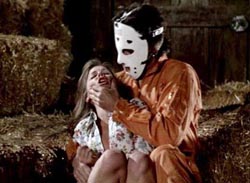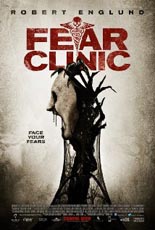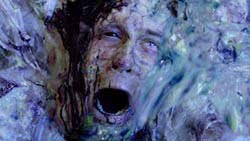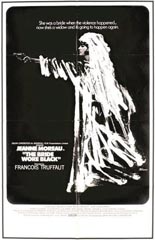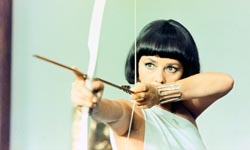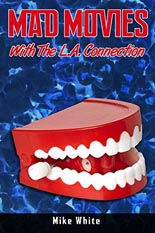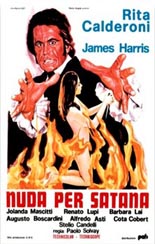
 Right away, as in mere seconds, the genius-titled Nude for Satan delivers on the “nude,” with a woman fleeing something at night. We’re not made to wait too long for the “Satan” part of the equation, either, assuming Ol’ Scratch is that guy who won’t cut out the cackling and has the blacked-out tooth — a safe bet, wouldn’t you agree? (As for “for,” well, let’s just give this slice of Italian cheesecake the benefit of the doubt.)
Right away, as in mere seconds, the genius-titled Nude for Satan delivers on the “nude,” with a woman fleeing something at night. We’re not made to wait too long for the “Satan” part of the equation, either, assuming Ol’ Scratch is that guy who won’t cut out the cackling and has the blacked-out tooth — a safe bet, wouldn’t you agree? (As for “for,” well, let’s just give this slice of Italian cheesecake the benefit of the doubt.)
How does one get au naturel for the Antichrist in the first place? Per writer/director Luigi Batzella (The Devil’s Wedding Night), the first step is to be like Dr. William Benson (Stelio Candelli, Demons) and assist a confused beauty like Susan (Rita Calderoni, Delirium), who’s just been injured an auto accident. Then you seek help at the nearest spooky castle, preferably inhabited by Beelzebub (James Harris of Jess Franco’s Kiss Me Killer) because the pieces naturally fall into place from there.
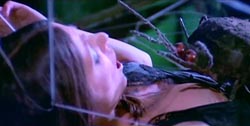 Inside the Gothic estate, time is suspended, which means Susan and the doc meet alternate-reality versions of themselves. That’s just for starters, as other strange stuff happens, from seeing painted images on canvas move to falling down a hole and into a room-sized spiderweb. The latter happens to Susan; upon landing with a bounce, her life-affirming right breast pops free and hangs out carefree for the remainder of the 82-minute wonder of softcore surrealism.
Inside the Gothic estate, time is suspended, which means Susan and the doc meet alternate-reality versions of themselves. That’s just for starters, as other strange stuff happens, from seeing painted images on canvas move to falling down a hole and into a room-sized spiderweb. The latter happens to Susan; upon landing with a bounce, her life-affirming right breast pops free and hangs out carefree for the remainder of the 82-minute wonder of softcore surrealism.
But I’m getting ahead of myself, so back to that web: Susan nearly becomes a midnight snack for a giant spider, so poorly made it would not be out-of-place in a small-town church spookhouse. The arachnid has somewhere between 10 and 12 legs, and looks like a dog turd rolled in hair. It also emits sound effects that merge space transmissions and sirens. Basically, it makes the robotic spider from a similar scene in 1965’s Bloody Pit of Horror look good.
Batzella’s work makes about as much sense as Batzella’s last name; he’s like a vo-tech Mario Bava, which equates this project to junior-college performance art, complete with dime-store fireworks, but tell me you don’t want to see that! Research tells me the Dutch added hardcore inserts to push Nude for Satan in full-on porn, but given the extra limbs the spider got, I shudder to think at what the humans might acquire in their triple-X translation. —Rod Lott

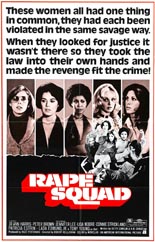
 Also known under the far less exploitative title of Act of Vengeance, the AIP release
Also known under the far less exploitative title of Act of Vengeance, the AIP release 